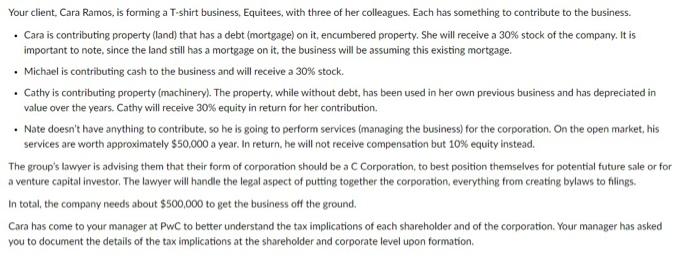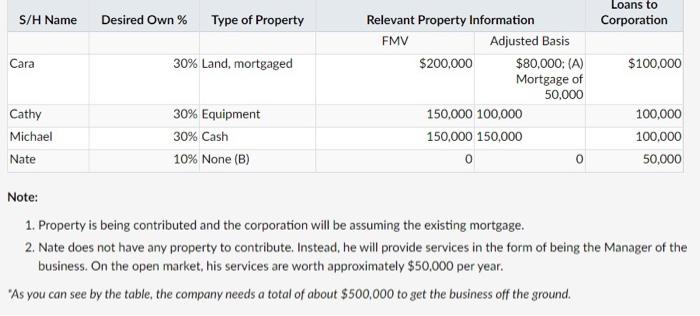Answered step by step
Verified Expert Solution
Question
1 Approved Answer
what more information is needed to answer this question? Your client, Cara Ramos, is forming a T-shirt business, Equitees, with three of her colleagues. Each




what more information is needed to answer this question?
Your client, Cara Ramos, is forming a T-shirt business, Equitees, with three of her colleagues. Each has something to contribute to the business. . Cara is contributing property (land) that has a debt (mortgage) on it, encumbered property. She will receive a 30% stock of the company. It is important to note, since the land still has a mortgage on it, the business will be assuming this existing mortgage. Michael is contributing cash to the business and will receive a 30% stock. Cathy is contributing property (machinery). The property, while without debt, has been used in her own previous business and has depreciated in value over the years. Cathy will receive 30% equity in return for her contribution Nate doesn't have anything to contribute, so he is going to perform services (managing the business for the corporation. On the open market, his services are worth approximately $50,000 a year. In return, he will not receive compensation but 10% equity instead. The group's lawyer is advising them that their form of corporation should be a C Corporation, to best position themselves for potential future sale or for a venture capital investor. The lawyer will handle the legal aspect of putting together the corporation everything from creating bylaws to filings. In total, the company needs about $500,000 to get the business off the ground. Cara has come to your manager at PwC to better understand the tax implications of each shareholder and of the corporation. Your manager has asked you to document the details of the tax implications at the shareholder and corporate level upon formation S/H Name Desired Own % Type of Property Loans to Corporation Cara 30% Land, mortgaged $100,000 Relevant Property Information FMV Adjusted Basis $200,000 $80,000: (A) Mortgage of 50,000 150,000 100,000 150,000 150,000 0 Cathy Michael Nate 30% Equipment 30% Cash 10% None (B) 100,000 100,000 50,000 Note: 1. Property is being contributed and the corporation will be assuming the existing mortgage. 2. Nate does not have any property to contribute. Instead, he will provide services in the form of being the Manager of the business. On the open market, his services are worth approximately $50,000 per year. "As you can see by the table, the company needs a total of about $500,000 to get the business off the ground. o o On the Shareholder tab, calculate the following areas for each shareholder: . Fair market value (FMV) of stock received Adjusted basis of stock received . Applicable basis code section . Realized gain (income) on transfer Recognized gain (income) on transfer . Gain (income) deferred, if present o On the Corporation tab, calculate the following for the corporation that is receiving the property: . FMV of property received Adjusted basis of property received . Applicable basis code section Realized gain (income) on property Recognized gain (income) on property Gain (income) deferred, if present Your client, Cara Ramos, is forming a T-shirt business, Equitees, with three of her colleagues. Each has something to contribute to the business. . Cara is contributing property (land) that has a debt (mortgage) on it, encumbered property. She will receive a 30% stock of the company. It is important to note, since the land still has a mortgage on it, the business will be assuming this existing mortgage. Michael is contributing cash to the business and will receive a 30% stock. Cathy is contributing property (machinery). The property, while without debt, has been used in her own previous business and has depreciated in value over the years. Cathy will receive 30% equity in return for her contribution Nate doesn't have anything to contribute, so he is going to perform services (managing the business for the corporation. On the open market, his services are worth approximately $50,000 a year. In return, he will not receive compensation but 10% equity instead. The group's lawyer is advising them that their form of corporation should be a C Corporation, to best position themselves for potential future sale or for a venture capital investor. The lawyer will handle the legal aspect of putting together the corporation everything from creating bylaws to filings. In total, the company needs about $500,000 to get the business off the ground. Cara has come to your manager at PwC to better understand the tax implications of each shareholder and of the corporation. Your manager has asked you to document the details of the tax implications at the shareholder and corporate level upon formation S/H Name Desired Own % Type of Property Loans to Corporation Cara 30% Land, mortgaged $100,000 Relevant Property Information FMV Adjusted Basis $200,000 $80,000: (A) Mortgage of 50,000 150,000 100,000 150,000 150,000 0 Cathy Michael Nate 30% Equipment 30% Cash 10% None (B) 100,000 100,000 50,000 Note: 1. Property is being contributed and the corporation will be assuming the existing mortgage. 2. Nate does not have any property to contribute. Instead, he will provide services in the form of being the Manager of the business. On the open market, his services are worth approximately $50,000 per year. "As you can see by the table, the company needs a total of about $500,000 to get the business off the ground. o o On the Shareholder tab, calculate the following areas for each shareholder: . Fair market value (FMV) of stock received Adjusted basis of stock received . Applicable basis code section . Realized gain (income) on transfer Recognized gain (income) on transfer . Gain (income) deferred, if present o On the Corporation tab, calculate the following for the corporation that is receiving the property: . FMV of property received Adjusted basis of property received . Applicable basis code section Realized gain (income) on property Recognized gain (income) on property Gain (income) deferred, if present Step by Step Solution
There are 3 Steps involved in it
Step: 1

Get Instant Access to Expert-Tailored Solutions
See step-by-step solutions with expert insights and AI powered tools for academic success
Step: 2

Step: 3

Ace Your Homework with AI
Get the answers you need in no time with our AI-driven, step-by-step assistance
Get Started


